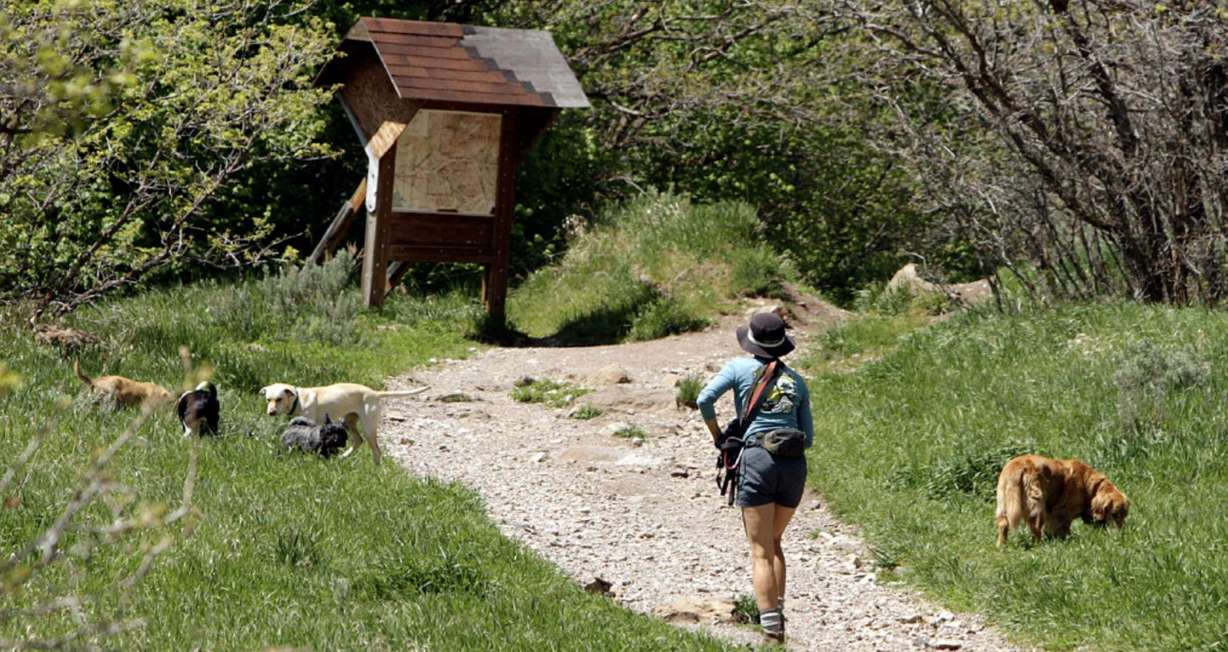- Hiking with pets requires extra planning, like checking trail restrictions and weather.
- Millcreek Canyon and Park City offer dog-friendly trails near Salt Lake City.
- Essential gear includes water, snacks, first aid, waste bags and protective clothing.
SALT LAKE CITY — Hiking with pets can be a fun way to bond with your furry friends. However, it may take a little additional planning. From packing extra water to choosing the right trail, there's a lot to consider.
Before setting out for a hiking trip with your beloved animal, check trailhead restrictions to make sure they're allowed in the area. For example, hiking with pets is prohibited in Big and Little Cottonwood canyons, as those areas are protected watersheds.
Millcreek Canyon is an alternative close to Salt Lake City, offering access to several dog-friendly hiking trails. Alternatively, the Park City side of Guardsman Pass permits animals.
Note Millcreek Canyon's leash policy. Pets must be leashed at all times on even-numbered calendar days. On odd-numbered days, they're welcome to roam free.

Similarly, hiking with pets is permitted on several popular trails in Salt Lake City's foothills. To find a trail that suits your and your pet's ability level, reference a website that provides details on difficulty, distance and elevation change. Examples include AllTrails and Gaia GPS.
Before embarking on the journey, check the weather forecast and temperature. Avoid hiking with pets during excessive heat. Checking conditions before you go can also help you make sure you're not caught in a storm.
New pet? Make sure they're up for it
If you're planning on hiking with pets that you just adopted, the American Kennel Club recommends checking with a veterinarian to make sure they're up for the challenge. Certain breeds may struggle to breathe.
Additionally, consider testing the waters before taking a new dog into the wilderness with a few walks around your neighborhood. Like people, dogs have their own personalities — some may be up for adventure while others prefer to stay home. If your puppy is just beginning to hike, take them on shorter, easier trails first. Their growing bodies need time to adjust to the exertion necessary to achieve longer distances.
Essential gear for hiking with pets
In addition to a sufficient supply of clean drinking water, the American Hiking Society recommends packing a collapsible bowl. Often made of silicone, they can be collapsed to fit in your backpack after your pet is done drinking from them.
Pack at least eight ounces of water for each hour of hiking for each dog. For example, if you'll be hiking for two hours with two dogs, the American Hiking Society recommends packing 32 ounces.
Letting your pet drink from natural water sources, such as rivers or ponds, is not recommended. The water could be contaminated with bacteria that can harm your four-legged buddy.
Similarly, pack nutritious snacks for your companion. Just like humans, eating along the way can help keep energy high.
As you prepare your hiking pack, include first aid essentials for your pet as well. You may recognize some common over-the-counter items used for humans, such as diphenhydramine and sterile gauze. When building a first aid kit for people or animals, the American Red Cross recommends packing it in a waterproof container.
Finally, ensure that you pack waste bags. According to the Environmental Protection Agency, cleaning up after your dog poops can help prevent the spread of certain bacteria, which may cause illness to other hikers or wildlife in the area. After using a plastic bag to scoop up the waste, tie it closed. When you come upon a trash can or pet waste bin, drop it inside.
Leaving the bag on the side of the trail is not proper trail etiquette and introduces plastic into the ecosystem.
Depending on the time of day and trail conditions, the American Hiking Society said you may also need to pack booties, a coat, or reflective gear for your dog.
Planning on heading to a rocky or icy trail? Pack booties to protect your dog's paws. If they haven't worn them before, consider letting them wear them around the house or on short walks to help them get used to them.

Lightweight jackets or rain coats can provide insulation if an unexpected storm arrives. Consider packing one in your hiking bag, just in case.
If you'll be recreating in dark conditions, such as around sunrise or sunset, add a light to your dog's leash or harness to improve visibility. Reflective materials on jackets or collars can also help.









